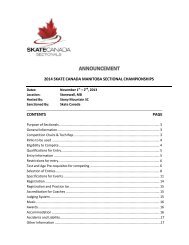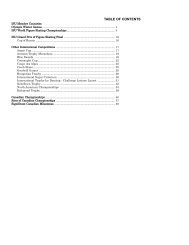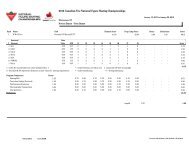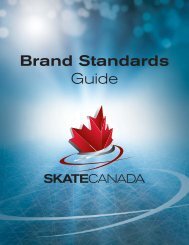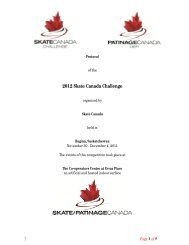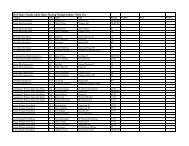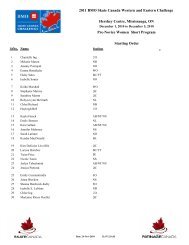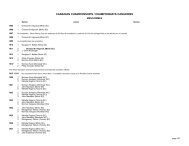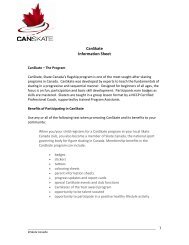LONG-TERM ATHLETE DEVELOPMENT - Skate Canada
LONG-TERM ATHLETE DEVELOPMENT - Skate Canada
LONG-TERM ATHLETE DEVELOPMENT - Skate Canada
You also want an ePaper? Increase the reach of your titles
YUMPU automatically turns print PDFs into web optimized ePapers that Google loves.
T H E 1 0 K E Y F A C T O R S I N F L U E N C I N G<br />
865 Sheord Road, Ottawa, Ontario K1J 1H9<br />
L O N G - T E R M Phone A613.747.1007 T H LI Toll EFree T1.888.747.2372 E D EI Fax V613.748.5718 E L OI Toll PFree MFax 1.877.211.2372 E N T<br />
There are 10 interrelated factors influencing long-term<br />
athlete development that are common to all sport<br />
organizations:<br />
1. At least 10 years to reach the top<br />
2. FUNdamentals<br />
3. Specialization<br />
4. Developmental age (growth, development,<br />
maturation)<br />
5. Windows of optimal trainability (5 S’s)<br />
6. Physical, mental, cognitive, and emotional<br />
development<br />
7. Periodization: planning, training, competition<br />
and recovery<br />
8. Domestic competition review<br />
9. System alignment and integration<br />
10. Continuous improvement<br />
These 10 factors greatly influenced the development<br />
of <strong>Skate</strong> <strong>Canada</strong>’s LTADM. The experts involved in the<br />
process continually visited and re-visited these factors<br />
to ensure that our model accurately reflects both<br />
contemporary realities facing our sport (and Canadian<br />
sport in general), as well as to provide a road map to<br />
help us get to where we want to be in the future.<br />
1. At Least 10 Years to Reach the Top<br />
Literature suggests that it takes at least 10 years or more<br />
and over 10,000 hours of training to reach international<br />
excellence. Of course, these 10,000 hours of training<br />
must be effective and take advantage of sensitive<br />
periods of athlete development. There are no shortcuts.<br />
Athlete development is a long-term process. Short-term<br />
performance goals must never be allowed to undermine<br />
long-term athlete development.<br />
2. FUNdamentals<br />
Success in sport, however defined, depends to a great<br />
extent on the development of physical literacy. This is<br />
defined as competency in fundamental movement skills<br />
(run, jump, throw, swim) and motor skills (ABC’s: agility,<br />
balance, coordination and speed), as well as basic sport<br />
skills.<br />
L o n g - Te r m A t h l e t e D e v e l o p m e n t<br />
7<br />
These three key components should be taught in a<br />
fun learning environment to equate physicality to<br />
enjoyment. It is our goal to ensure that all members<br />
registering in a <strong>Skate</strong> <strong>Canada</strong> program learn and<br />
incorporate the basics early in their involvement in<br />
the sport. Children should develop physical literacy<br />
before the onset of their growth spurt. Without these<br />
basic movement skills and motor skills a child will have<br />
difficulty participating in any sport and will have fewer<br />
opportunities for athletic success and lifelong enjoyment<br />
of physical activity.<br />
Getting the Sequence Right<br />
For children to have success in sport – either as a health<br />
related recreational activity or in competition, it is<br />
important that they master fundamental movement<br />
skills before learning fundamental sport skills, and<br />
important that they learn fundamental sport skills before<br />
being introduced to specific techniques.



